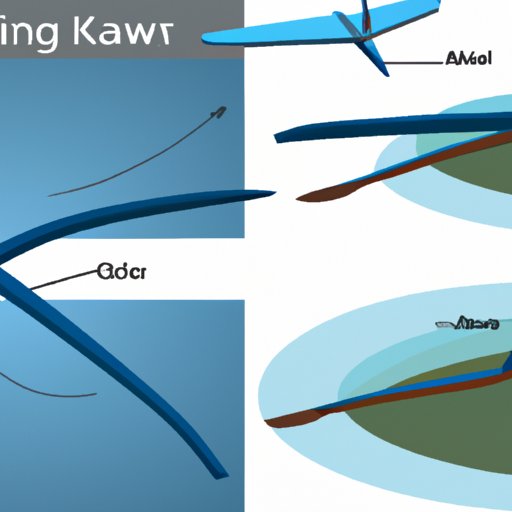Introduction
A boomerang is a unique and ancient tool that has been used by many different cultures for centuries. It is a curved object made from wood or other lightweight materials that is designed to be thrown and then return to the thrower. The physics behind this remarkable object remain a mystery to many, but the science behind it is quite fascinating.
Exploring the Physics of Boomerangs: How Does It Work?
The physics behind the flight of a boomerang are complex and involve principles of flight, dynamics, aerodynamic forces, and the power of air resistance. To understand how a boomerang works, one must first understand these basic concepts.
Principles of Flight and Dynamics
In order for a boomerang to fly, it needs lift. Lift is generated by the shape and movement of the boomerang. As the boomerang moves through the air, the air pressure on the top of the boomerang is greater than the air pressure on the bottom. This difference in air pressure generates lift and causes the boomerang to rise. Additionally, the boomerang’s spin helps it maintain stability and control. As the boomerang spins, it creates gyroscopic forces that help keep it stable in the air and prevent it from tumbling out of control.
Aerodynamic Forces
Aerodynamic forces play an important role in the flight of a boomerang. As the boomerang moves through the air, the air molecules flow over the surface of the boomerang. This creates a layer of air called the boundary layer. This boundary layer creates drag, which is a force that opposes the motion of the boomerang. Drag also affects the trajectory of the boomerang, causing it to curve as it moves through the air.
Power of Air Resistance
Air resistance is another key factor in the flight of a boomerang. As the boomerang moves through the air, the air molecules create friction against the surface of the boomerang. This friction creates drag, which slows down the boomerang and causes it to change direction. This is why a boomerang will eventually return to the thrower, even if it is thrown in a straight line.
A Comprehensive Guide to Boomerangs: Design and Mechanics
To better understand the flight of a boomerang, it is important to understand the design and mechanics of a boomerang. Every boomerang is slightly different, but all boomerangs share certain characteristics that make them work.
Deconstructing a Boomerang’s Design
Boomerangs come in many shapes and sizes, but they all have a few key features in common. Most boomerangs have two wings that are connected by a central axis. These wings are curved and have a slight twist, which helps generate lift. Additionally, the wings have a leading edge, which is the front of the boomerang, and a trailing edge, which is the back of the boomerang. Both the leading edge and the trailing edge are important for creating lift and keeping the boomerang stable in the air.
Investigating the Flight Path
The flight path of a boomerang is determined by its design and the forces acting on it. When thrown, the boomerang will move in a curved path due to the aerodynamic forces acting on it. Additionally, the spin of the boomerang helps keep it stable in the air and prevents it from tumbling out of control. As the boomerang moves through the air, air resistance will slow it down and cause it to eventually return to the thrower.
Unveiling the Mysteries of Boomerang Flight
When thrown correctly, a boomerang can travel a great distance and return to the thrower. It is a remarkable feat of engineering and physics that has captivated people for centuries. Though the mysteries of boomerang flight may never be fully understood, the science behind it is quite fascinating.
Conclusion
A boomerang is an iconic tool of ancient cultures that has captivated people for centuries. The science behind its mysterious flight patterns is complex and involves principles of flight, dynamics, aerodynamic forces, and the power of air resistance. By understanding the design and mechanics of a boomerang, one can gain a deeper appreciation for this amazing object.
As Albert Einstein once said, “Look deep into nature, and then you will understand everything better.” By exploring the physics behind boomerangs, we can gain a greater understanding of the world around us and appreciate the wonders of nature.
Summary of Key Points
• A boomerang is a curved object that is designed to be thrown and then return to the thrower.
• Principles of flight, dynamics, aerodynamic forces, and air resistance all play a role in the flight of a boomerang.
• A boomerang’s design is critical for generating lift, maintaining stability, and controlling its trajectory.
• By exploring the physics behind boomerangs, we can gain a greater understanding of the world around us.
Further Resources
• How Boomerangs Work (https://science.howstuffworks.com/boomerang4.htm)
• The Physics of Boomerangs (https://www.thoughtco.com/the-physics-of-boomerangs-1991061)
• Boomerang Aerodynamics (http://boomerang.org/aerodynamics.
(Note: Is this article not meeting your expectations? Do you have knowledge or insights to share? Unlock new opportunities and expand your reach by joining our authors team. Click Registration to join us and share your expertise with our readers.)
